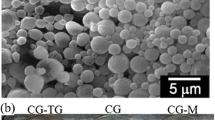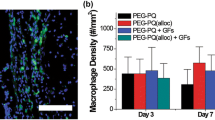Abstract
Purpose
To attain the effective local and sustained delivery of plasmid DNA (pDNA) encoding for a growth factor.
Methods
We hypothesized that controlling the degradation rate of biomaterials encapsulating pDNA via concurrent physical dissociation of the cross-linked structure and hydrolytic chain breakage of polymers would allow one to significantly broaden the range of pDNA release rate. This hypothesis was examined using ionically cross-linked polysaccharide hydrogels which were previously designed to rapidly degrade via engineering of ionic cross-linking junction and partial oxidation of polysaccharide chains.
Results
The hydrogel degradation rates were varied over the broad range, and pDNA release correlated with the gel degradation rate. Degradable hydrogels were used for the local and sustained delivery of a pDNA encoding for vascular endothelial growth factor (VEGF) in the ischemic hindlimbs of mice, and local pDNA release significantly improved the recovery of blood perfusion as compared with a bolus injection of VEGFencoding pDNA.
Conclusion
This strategy to control the hydrogel degradation rate may be useful in regulating the delivery of a broad array of macromolecular drugs, and subsequently improve their therapeutic efficacy.






Similar content being viewed by others
References
D. W. Losordo and S. Dimmeler. Therapeutic angiogenesis and vasculogenesis for ischemic disease—Part II: Cell-based therapies. Circulation 109:2692–2697 (2004).
D. W. Losordo and S. Dimmeler. Therapeutic angiogenesis and vasculogenesis for ischemic disease—Part I: Angiogenic cytokines. Circulation 109:2487–2491 (2004).
J. M. Isner. Myocardial gene therapy. Nature 415:234–239 (2002).
A. A. Kocher, M. D. Schuster, M. J. Szabolcs, S. Takuma, D. Burkhoff, J. Wang, S. Homma, N. M. Edwards, and S. Itescu. Neovascularization of ischemic myocardium by human bone-marrow-derived angioblasts prevents cardiomyocyte apoptosis, reduces remodeling and improves cardiac function. Nat. Med. 7:430–436 (2001).
J. M. Isner, and D. W. Losordo. Therapeutic angiogenesis for heart failure. Nat. Med. 5:491–492 (1999).
T. P. Richardson, M. C. Peters, A. B. Ennett, and D. J. Mooney. Polymeric system for dual growth factor delivery. Nat. Biotechnol. 19:1029–1034 (2001).
F. J. Giordano, P. P. Ping, M. D. McKirnan, S. Nozaki, A. N. DeMaria, W. H. Dillmann, O. MathieuCostello, and H. K. Hammond. Intracoronary gene transfer of fibroblast growth factor-5 increases blood flow and contractile function in an ischemic region of the heart. Nat. Med. 2:534–539 (1996).
Y. Tsurumi, S. Takeshita, D. F. Chen, M. Kearney, S. T. Rossow, J. Passeri, J. R. Horowitz, J. F. Symes, and J. M. Isner. Direct intramuscular gene transfer of naked DNA encoding vascular endothelial growth factor augments collateral development and tissue perfusion. Circulation 94:3281–3290 (1996).
S. Takeshita, Y. Tsurumi, T. Couffinahl, T. Asahara, C. Bauters, J. Symes, N. Ferrara, and J. M. Isner. Gene transfer of naked DNA encoding for three isoforms of vascular endothelial growth factor stimulates collateral development in vivo. Lab. Invest. 75:487–501 (1996).
X. J. Hao, A. Mansson-Broberg, P. Blomberg, G. Dellgren, A. J. Siddiqui, K. H. Grinnemo, E. Wardell, and C. Sylven. Angiogenic and cardiac functional effects of dual gene transfer of VEGF-A(165) and PDGF-BB after myocardial infarction. Biochem. Biophys. Res. Commun. 322:292–296 (2004).
A. J. Comerota, R. C. Throm, K. A. Miller, T. Henry, N. Chronos, J. Laird, R. Sequeira, C. K. Kent, M. Bacchetta, C. Goldman, J. P. Salenius, F. A. Schmieder, and R. Pilsudski. Naked plasmid DNA encoding fibroblast growth factor type I for the treatment of end-stage unreconstructible lower extremity ischemia: Preliminary results of a phase I trial. J. Vasc. Surg. 35:930–936 (2002).
C. Madeira, L. M. S. Loura, M. R. Aires-Barros, A. Fedorov, and M. Prieto. Characterization of DNA/lipid complexes by fluorescence resonance energy transfer. Biophys. J. 85:3106–3119 (2003).
M. D. Brown, A. G. Schatzlein, and I. F. Uchegbu. Gene delivery with synthetic (non viral) carriers. Int. J. Pharm. 229:1–21 (2001).
C. L. Densmore, F. M. Orson, B. Xu, B. M. Kinsey, J. C. Waldrep, P. Hua, B. Bhogal, and V. Knight. Aerosol delivery of robust polyethyleneimine-DNA complexes for gene therapy and genetic immunization. Molec. Ther. 1:180–188 (2000).
L. J. Branden, A. J. Mohamed, and C. I. E. Smith. A peptide nucleic acid-nuclear localization signal fusion that mediates nuclear transport of DNA. Nat. Biotechnol. 17:784–787 (1999).
R. C. Adami, W. T. Collard, S. A. Gupta, K. Y. Kwok, J. Bonadio, and K. G. Rice. Stability of peptide condensed plasmid DNA formulations. J. Pharm. Sci. 87:678–683 (1998).
P. L. Felgner, T. R. Gadek, M. Holm, R. Roman, H. W. Chan, M. Wenz, J. P. Northrop, G. M. Ringold, and M. Danielsen. Lipofection—A highly efficient, lipid-mediated DNA-transfection procedure. Proc. Natl. Acad. Sci. U. S. A. 84:7413–7417 (1987).
E. A. Silva, and D. J. Mooney. Spatiotemporal control of vascular endothelial growth factor delivery from injectable hydrogels enhances angiogenesis. J. Thrombos. Haemost. 5:590–598 (2007).
D. H. Walter, M. Cejna, L. Diaz-Sandoval, S. Willis, L. Kirkwood, P. W. Stratford, A. B. Tietz, R. Kirchmair, M. Silver, C. Curry, A. Wecker, Y. S. Yoon, R. Heidenreich, A. Hanley, M. Kearney, F. O. Tio, P. Kuenzler, J. M. Isner, and D. W. Losordo. Local gene transfer of phVEGF-2 plasmid by gene-eluting stents—An alternative strategy for inhibition of restenosis. Circulation 110:36–45 (2004).
Y. X. Lu, J. Shansky, M. Del Tatto, P. Ferland, X. Y. Wang, and H. Vandenburgh. Recombinant vascular endothelial growth factor secreted from tissue-engineered bioartificial muscles promotes localized angiogenesis. Circulation 104:594–599 (2001).
J. Bonadio, E. Smiley, P. Patil, and S. Goldstein. Localized, direct plasmid gene delivery in vivo: prolonged therapy results in reproducible tissue regeneration. Nat. Med. 5:753–759 (1999).
L. De Laporte, and L. D. Shea. Matrices and scaffolds for DNA delivery in tissue engineering. Adv. Drug Deliv. Rev. 59:292–307 (2007).
J. H. Jang, C. B. Rives, and L. D. Shea. Plasmid delivery in vivo from porous tissue-engineering scaffolds: Transgene expression and cellular tansfection. Molec. Ther. 12:475–483 (2005).
S. Jilek, H. Zurkaulen, J. Pavlovic, H. P. Merkle, and E. Walter. Transfection of a mouse dendritic cell line by plasmid DNA-loaded PLGA microparticles in vitro. Eur. J. Pharm. Biopharm. 58:491–499 (2004).
J. H. Jeong, and T. G. Park. Novel polymer-DNA hybrid polymeric micelles composed of hydrophobic poly(d,l-lactic-co-glycolic acid) and hydrophilic oligonucleotides. Bioconjug. Chem. 12:917–923 (2001).
Y. Fukunaka, K. Iwanaga, K. Morimoto, M. Kakemi, and Y. Tabata. Controlled release of plasmid DNA from cationized gelatin hydrogels based on hydrogel degradation. J. Control. Release 80:333–343 (2002).
Z. H. Li, W. Ning, J. M. Wang, A. Choi, P. Y. Lee, P. Tyagi, and L. Huang. Controlled gene delivery system based on thermosensitive biodegradable hydrogel. Pharm. Res. 20:884–888 (2003).
F. K. Kasper, S. K. Seidlits, A. Tang, R. S. Crowther, D. H. Carney, M. A. Barry, and A. G. Mikos. In vitro release of plasmid DNA from oligo(poly(ethylene glycol) fumarate) hydrogels. J. Control. Release 104:521–539 (2005).
J. A. Wieland, T. L. Houchin-Ray, and L. D. Shea. Non-viral vector delivery from PEG-hyaluronic acid hydrogels. J. Control. Release 120:233–241 (2007).
H. J. Kong, E. Alsberg, D. Kaigler, K. Y. Lee, and D. J. Mooney. Controlling degradation of hydrogels via the size of cross-linked junctions. Adv. Mater. 16:1917–1921 (2004).
H. J. Kong, D. Kaigler, K. Kim, and D. J. Mooney. Controlling rigidity and degradation of alginate hydrogels via molecular weight distribution. Biomacromolecules 5:1720–1727 (2004).
K. S. Anseth, C. N. Bowman, and L. BrannonPeppas. Mechanical properties of hydrogels and their experimental determination. Biomaterials 17:1647–1657 (1996).
H. J. Kong, S. Hsiong, and D. J. Mooney. Nanoscale cell adhesion ligand presentation regulates nonviral gene delivery and expression. Nano Lett. 7:161–166 (2007).
T. Couffinhal, M. Silver, L. P. Zheng, M. Kearney, B. Witzenbichler, and J. M. Isner. Mouse model of angiogenesis. Am. J. Pathol. 152:1667–1679 (1998).
Y. B. Xie, S. T. Yang, and D. A. Kniss. Three-dimensional cell-scaffold constructs promote efficient gene transfection: Implications for cell-based gene therapy. Tissue Eng. 7:585–598 (2001).
N. J. Meilander-Lin, P. J. Cheung, D. L. Wilson, and R. V. Bellamkonda. Sustained in vivo gene delivery from agarose hydrogel prolongs nonviral gene expression in skin. Tissue Eng. 11:546–555 (2005).
S. Jain, W. T. Yap, and D. J. Irvine. Synthesis of protein-loaded hydrogel particles in an aqueous two-phase system for coincident antigen and CpG oligonucleotide delivery to antigen-presenting cells. Biomacromolecules 6:2590–2600 (2005).
Acknowledgement
The authors thank the NIH (RO1 DE013033 and RO1 HL069957) for the financial support of this research. The authors also thank Mr. Francis Rauh of FMC Corporation for supplying the alginate samples.
Author information
Authors and Affiliations
Corresponding author
Rights and permissions
About this article
Cite this article
Kong, H.J., Kim, E.S., Huang, YC. et al. Design of Biodegradable Hydrogel for the Local and Sustained Delivery of Angiogenic Plasmid DNA. Pharm Res 25, 1230–1238 (2008). https://doi.org/10.1007/s11095-007-9526-7
Received:
Accepted:
Published:
Issue Date:
DOI: https://doi.org/10.1007/s11095-007-9526-7




